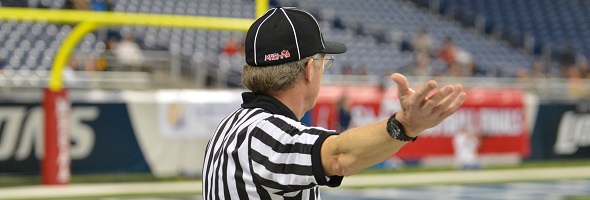
Be the Referee: Play Clock Experiment
September 1, 2016
This week, MHSAA assistant director Mark Uyl explains the 40-second game clock Michigan football schools are allowed to try this fall.
Be The Referee is a series of short messages designed to help educate people on the rules of different sports, to help them better understand the art of officiating, and to recruit officials.
Below is this week's segment – Play Clock Experiment - Listen
From time to time, the MHSAA receives permission from the national rules making body, the National Federation of State High School Associations, to experiment with a new rule.
This fall in high school football, Michigan schools can experiment with a 40-second play clock. In this experiment, the 40-second play clock begins at the end of the previous play, giving teams consistency from week to week when the offense can next snap the ball.
With using the traditional 25-second play clock, it really depends on the referee of the game in terms of the pace on how quickly the offenses can go.
Past editions
Aug. 25: Clipping in the Free Blocking Zone - Listen

Be the Referee: 3-Second Rule
March 5, 2020
This week, MHSAA assistant director Brent Rice explains one of the most misunderstood rules in basketball – the 3-second rule.
Be The Referee is a series of short messages designed to help educate people on the rules of different sports, to help them better understand the art of officiating, and to recruit officials.
Below is this week's segment - Misunderstood Rules: 3 Seconds - Listen
It’s hard to go to a basketball game and not sit near other fans who are yelling about the officials not calling three seconds. The 3-second rule is one of the most misunderstood rules in the game of basketball.
The purpose and philosophy of the rule is to not allow a player who is significantly taller than his or her opponent to camp out in the middle of the lane and create an unfair advantage. The 3-second count is in effect whenever an offensive player has at least one foot in the lane when his or her team is in possession of the ball. That count stops as soon as a try – a shot – is attempted or a try is imminent; and the count cannot start again until there is control of a rebound.
Keep this in mind at the next game you attend.
Past editions
Feb. 27: Clarifying Takedowns - Listen
Feb. 20: Basketball Officials Manual - Listen
Feb. 13: Held Ball or Traveling - Listen
Feb. 6: Hockey Rules Chart - Listen
Jan. 30: Cheer Safety - Listen
Jan. 23: Goaltending - Listen
Jan. 16: Wrestling Tie-Breaker - Listen
Jan. 9: Pregame Meeting - Listen
Dec. 19: Alternating Possession - Listen
Dec. 12: Ratings - Listen
Dec. 5: Video Review Success - Listen
Nov. 28: More Injury Time - Listen
Nov. 21: Football Review - Listen
Nov. 14: Sideline Safety - Listen
Nov. 7: Officials Playlist - Listen
Oct. 31: Most Important Line - Listen
Oct. 24: Automatic 1st Downs - Listen
Oct. 17: Catch Momentum - Listen
Oct. 10: Golf Rules Changes - Listen
Oct. 3: No Tackle Box - Listen
Sept. 26: You Make the Overtime Call - Listen
Sept. 19: Swimming Finishing Touch - Listen
Sept. 12: Curbing Gamesmanship By Substitution - Listen
Sept. 5: Football Safety Rules Changes - Listen
Aug. 29: 40-Second Play Clock - Listen

